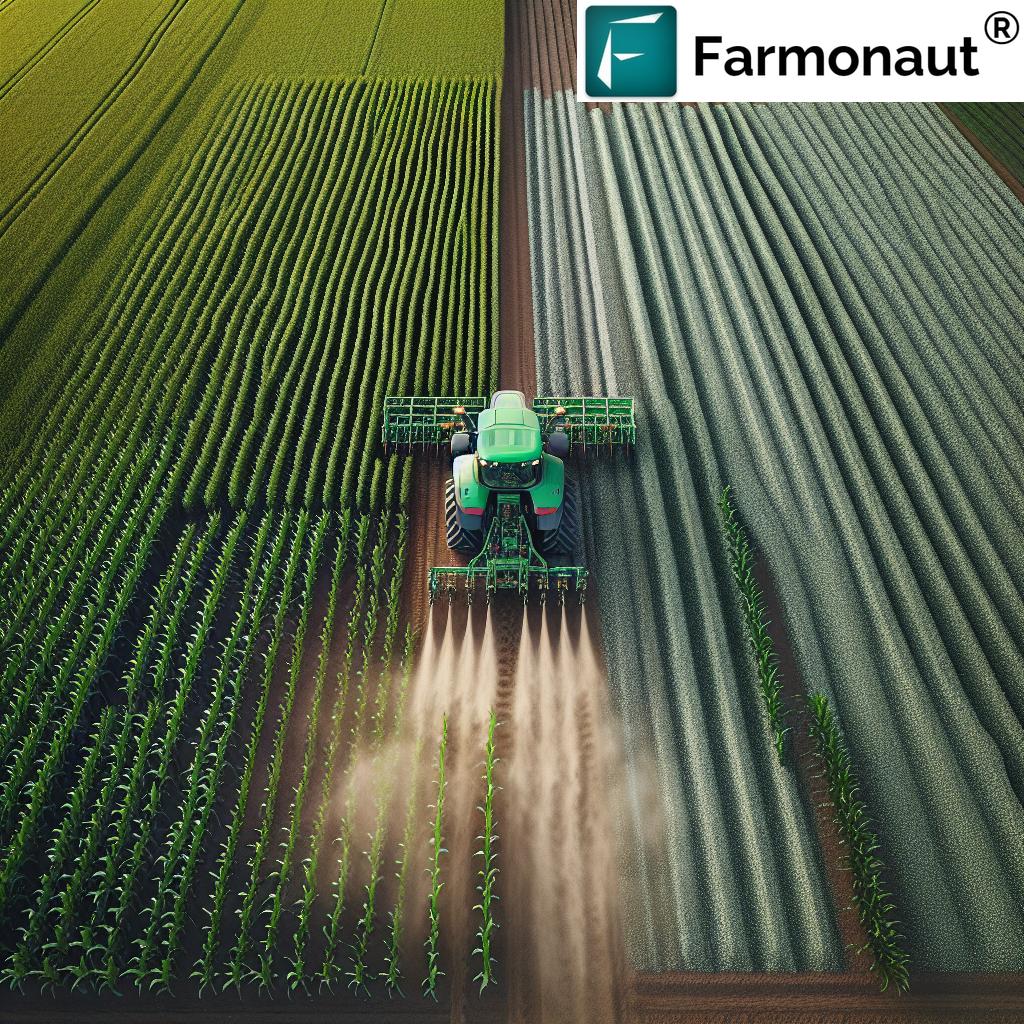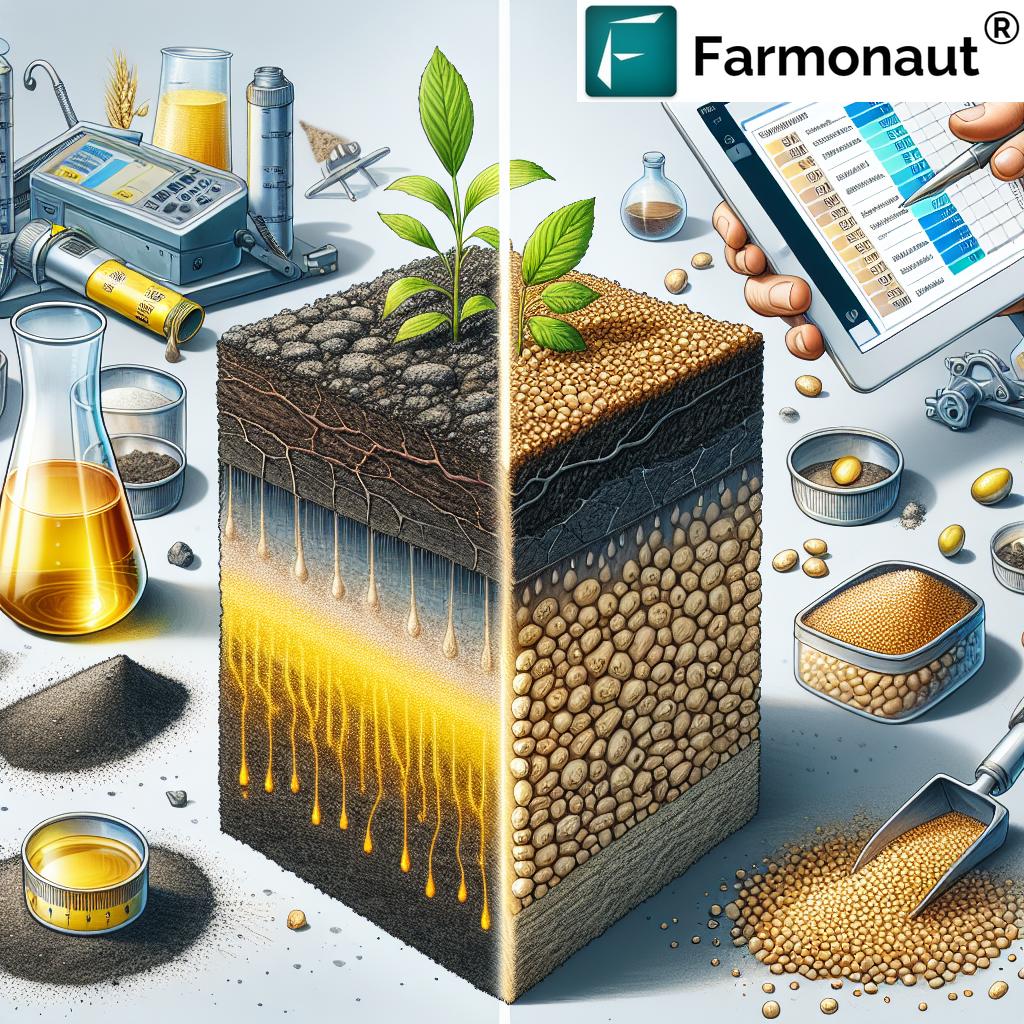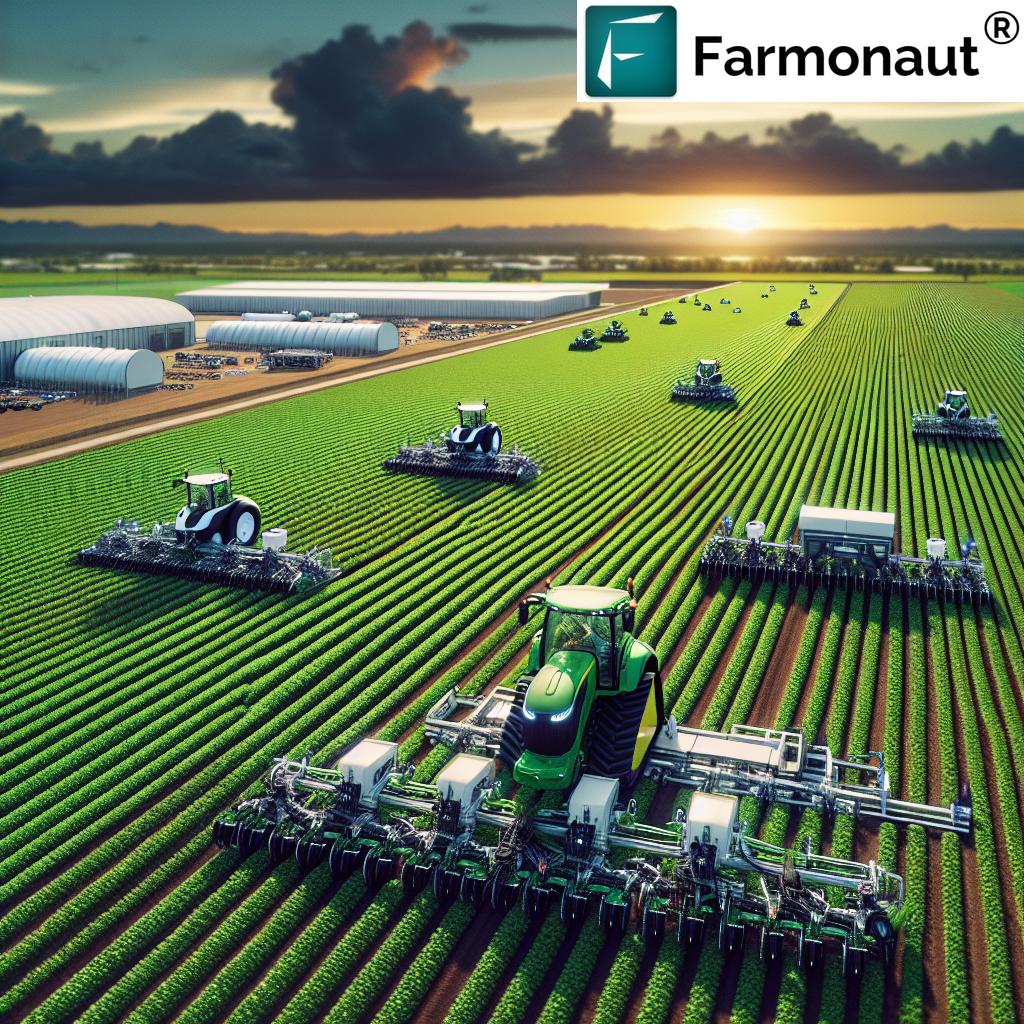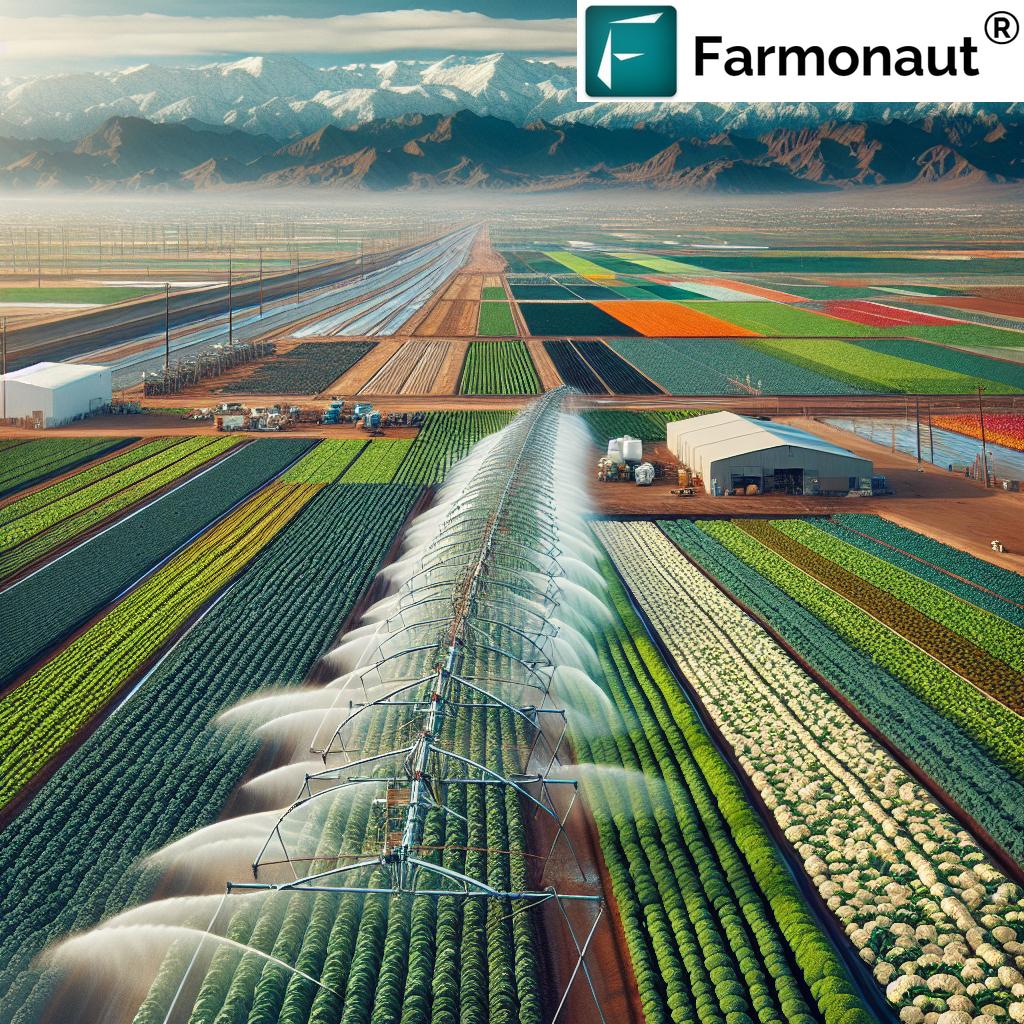Liquid vs Granular Fertilizer: Optimizing Nutrient Management for Maximum Crop Yield in US Agriculture
“Applying fertilizer using the 4R approach (right form, place, time, rate) can increase crop yields by up to 30%.”
In the ever-evolving landscape of US agriculture, the quest for optimal crop yield and sustainable farming practices has led to a crucial debate: liquid versus granular fertilizer. As we delve into this comprehensive exploration of nutrient management, we’ll uncover the intricacies of these two fertilizer forms and their impact on agricultural efficiency. Our journey through this topic will not only shed light on the advantages and challenges of each type but also provide valuable insights into how farmers can make informed decisions to maximize their crop yields.
Understanding the Basics: Liquid and Granular Fertilizers
Before we dive into the comparison, let’s establish a foundational understanding of liquid and granular fertilizers:
- Liquid Fertilizers: These are nutrients dissolved in water or other liquid carriers. They can be applied through irrigation systems, sprayed directly onto leaves, or injected into the soil.
- Granular Fertilizers: These are dry, pelletized forms of nutrients that are spread on the soil surface or incorporated into the soil.
Both forms contain essential nutrients like nitrogen, phosphorus, and potassium, but their physical properties lead to differences in application methods, nutrient availability, and overall effectiveness.

The Four Rs of Fertilizer Application
At the heart of effective nutrient management lies the concept of the “Four Rs” – Right Source, Right Rate, Right Time, and Right Place. This framework, crucial for both liquid and granular fertilizers, guides farmers in optimizing their fertilizer use:
- Right Source: Choosing the appropriate fertilizer type (liquid or granular) based on crop needs and soil conditions.
- Right Rate: Applying the correct amount of nutrients to meet crop requirements without excess.
- Right Time: Timing the application to coincide with critical growth stages and environmental conditions.
- Right Place: Ensuring nutrients are placed where crops can access them most efficiently.
Understanding how liquid and granular fertilizers perform within this framework is key to making informed decisions about nutrient management.
Comparing Liquid and Granular Fertilizers
Let’s break down the comparison between liquid and granular fertilizers across several critical factors:
| Factors | Liquid Fertilizers | Granular Fertilizers |
|---|---|---|
| Nutrient availability speed | Fast | Moderate to Slow |
| Uniformity of distribution | High | Moderate |
| Precision application | High | Moderate |
| Risk to seedlings | Low | Moderate to High |
| Equipment requirements | Specialized | Standard |
| Storage considerations | Complex | Simple |
| Soil type suitability | All types | Better for heavier soils |
| Application timing flexibility | High | Moderate |
| Cost-effectiveness | Variable | Generally lower initial cost |
| Environmental impact | Lower risk of runoff | Higher risk of runoff |
Nutrient Availability and Spatial Distribution
One of the most significant differences between liquid and granular fertilizers lies in how quickly nutrients become available to plants and how they distribute in the soil:
- Liquid Fertilizers:
- Provide rapid nutrient availability as they’re already in solution.
- Offer more uniform distribution throughout the soil profile.
- Can be beneficial for addressing immediate nutrient deficiencies.
- Granular Fertilizers:
- Tend to release nutrients more slowly as they dissolve.
- May create nutrient “hot spots” around granules.
- Can provide a more sustained nutrient release over time.
The choice between liquid and granular forms can significantly impact the spatial availability of nutrients in the soil, influencing root development and overall crop health.
Precision Farming and Nutrient Placement
In the era of precision agriculture, the ability to apply fertilizers with pinpoint accuracy has become increasingly important. Here’s how liquid and granular fertilizers compare in this aspect:
- Liquid Fertilizers:
- Can be easily integrated with precision farming equipment.
- Allow for variable rate application across fields.
- Facilitate precise placement near plant roots or through foliar application.
- Granular Fertilizers:
- Require specialized equipment for precise placement.
- Can be more challenging to apply at variable rates.
- May be less efficient in no-till or conservation tillage systems.
“Precision farming techniques using liquid fertilizers can reduce nutrient runoff by 15-20% compared to traditional granular applications.”
The ability to precisely place nutrients where they’re needed most can significantly improve nutrient use efficiency and reduce environmental impacts. Farmonaut’s satellite-based crop monitoring technology can play a crucial role in optimizing fertilizer application by providing detailed insights into crop health and soil conditions.

Impact on Crop Emergence and Early Growth
The form of fertilizer can significantly affect crop emergence and early growth stages, particularly for sensitive crops:
- Liquid Fertilizers:
- Generally pose lower risk of “fertilizer burn” to seedlings.
- Can be easily absorbed by young plants.
- Allow for more precise nutrient ratios tailored to early growth needs.
- Granular Fertilizers:
- May present a higher risk of seed damage if placed too close.
- Can create localized areas of high salt concentration.
- May require careful placement to avoid hindering emergence.
For crops like corn and soybeans, which are particularly sensitive during emergence, the choice between liquid and granular fertilizers can be crucial for ensuring a strong start to the growing season.
Soil Type Considerations
The effectiveness of liquid versus granular fertilizers can vary depending on soil type:
- Sandy Soils:
- Liquid fertilizers may be more effective due to faster penetration.
- Risk of leaching is higher with both forms, but especially with liquids.
- Clay Soils:
- Granular fertilizers may provide more sustained release.
- Liquid fertilizers can help with immediate nutrient availability in compacted soils.
- Loamy Soils:
- Both forms can be effective, with choice depending on other factors.
Understanding your soil type is crucial for making the right choice between liquid and granular fertilizers. Farmonaut’s soil moisture monitoring capabilities can provide valuable insights to inform these decisions.
Environmental Considerations and Sustainable Agriculture
As we strive for more sustainable agricultural practices, the environmental impact of fertilizer application becomes increasingly important:
- Nutrient Runoff: Liquid fertilizers, when applied correctly, may have a lower risk of surface runoff compared to granular forms.
- Leaching: Both forms can contribute to nutrient leaching, but proper application timing and rates can mitigate this risk.
- Carbon Footprint: The production and transportation of liquid fertilizers may have a higher carbon footprint due to water content.
Implementing precision farming techniques, such as those enabled by Farmonaut’s satellite-based crop monitoring, can significantly reduce the environmental impact of fertilizer use by ensuring more efficient and targeted application.
Economic Considerations: Cost-Effectiveness and Infrastructure
The economic aspects of choosing between liquid and granular fertilizers extend beyond just the price per unit of nutrient:
- Initial Costs: Granular fertilizers often have a lower upfront cost.
- Equipment Investment: Liquid fertilizers may require specialized application equipment.
- Storage and Handling: Granular fertilizers are generally easier and less expensive to store.
- Application Efficiency: Liquid fertilizers can offer cost savings through more precise application and reduced waste.
Farmers must consider their existing infrastructure, equipment, and long-term economic goals when choosing between liquid and granular fertilizers.
Crop-Specific Considerations
Different crops may respond better to certain fertilizer forms:
- Corn: Often benefits from a combination approach, with starter fertilizers in liquid form and later applications in granular form.
- Soybeans: May respond well to foliar applications of liquid micronutrients.
- Wheat and other cereals: Can benefit from both forms, with timing being a crucial factor.
- Canola: Often responds well to liquid fertilizers, especially for micronutrient applications.
Understanding the specific nutritional needs and growth patterns of your crops is essential for optimizing fertilizer choice and application methods.
Integrating Technology in Nutrient Management
Modern farming relies heavily on technology to optimize nutrient management. Farmonaut’s satellite-based crop monitoring system plays a crucial role in this aspect:
- Provides real-time data on crop health and soil conditions.
- Enables precise mapping of nutrient deficiencies across fields.
- Supports variable rate application of both liquid and granular fertilizers.
- Helps in tracking the effectiveness of different fertilizer applications over time.
By leveraging such advanced technologies, farmers can make more informed decisions about when, where, and how to apply fertilizers, regardless of the form they choose.
Practical Implementation: Blending Strategies
In practice, many successful farmers adopt a blended approach to fertilizer use:
- Starter Fertilizers: Often liquid forms are used for quick availability during planting.
- In-Season Applications: A mix of liquid foliar sprays and granular side-dressings based on crop needs.
- Post-Harvest: Granular fertilizers may be preferred for building soil fertility for the next season.
This flexible approach allows farmers to leverage the benefits of both liquid and granular fertilizers throughout the growing season.
Future Trends in Nutrient Management
As we look to the future of agriculture, several trends are shaping the landscape of nutrient management:
- Enhanced Efficiency Fertilizers: Both liquid and granular forms are being developed with coatings or inhibitors to improve nutrient use efficiency.
- Precision Agriculture: Continued advancements in technology, like those offered by Farmonaut, will enable even more precise and targeted fertilizer applications.
- Sustainable Practices: Growing emphasis on reducing environmental impact will drive innovations in fertilizer formulations and application methods.
- Integrated Nutrient Management: Holistic approaches that combine organic and inorganic nutrient sources are gaining popularity.
Staying informed about these trends and adopting new technologies will be crucial for farmers looking to optimize their nutrient management strategies.
Conclusion: Making the Right Choice for Your Farm
The debate between liquid and granular fertilizers doesn’t have a one-size-fits-all answer. The best choice depends on a variety of factors including:
- Soil type and condition
- Crop requirements
- Existing farm infrastructure
- Environmental considerations
- Economic factors
By carefully considering these factors and leveraging advanced technologies like Farmonaut’s satellite-based crop monitoring, farmers can make informed decisions that optimize their nutrient management strategies. Remember, the goal is not just to choose between liquid and granular fertilizers, but to implement a comprehensive nutrient management plan that maximizes crop yield while minimizing environmental impact and costs.
As we continue to face challenges in global agriculture, from feeding a growing population to adapting to climate change, efficient and sustainable nutrient management will play a crucial role. By staying informed, adopting new technologies, and continuously refining their approaches, US farmers can lead the way in developing resilient and productive agricultural systems for the future.
FAQs
- Q: Can I switch from granular to liquid fertilizers without changing my equipment?
A: In most cases, switching from granular to liquid fertilizers will require some equipment changes or adaptations. Liquid fertilizers typically need specialized tanks, pumps, and nozzles for application. - Q: Are liquid fertilizers more environmentally friendly than granular ones?
A: Liquid fertilizers can be more environmentally friendly in terms of reduced runoff risk when applied correctly. However, both types can be used sustainably with proper management practices. - Q: How does soil pH affect the choice between liquid and granular fertilizers?
A: Soil pH can influence nutrient availability regardless of fertilizer form. However, liquid fertilizers may provide a slight advantage in high pH soils by allowing for more immediate nutrient uptake. - Q: Can I use Farmonaut’s technology with both liquid and granular fertilizer applications?
A: Yes, Farmonaut’s satellite-based crop monitoring can be used to optimize the application of both liquid and granular fertilizers by providing insights into crop health and soil conditions. - Q: Are there any crops that specifically benefit from one form of fertilizer over the other?
A: While most crops can benefit from both forms, some crops like corn often respond well to a combination of liquid starter fertilizers and granular applications later in the season.
For more information on how Farmonaut’s technology can help optimize your nutrient management strategy, regardless of your fertilizer choice, visit our website or download our mobile app:
For developers interested in integrating Farmonaut’s satellite and weather data into their own systems, check out our API and API Developer Docs.
Farmonaut Subscriptions
















